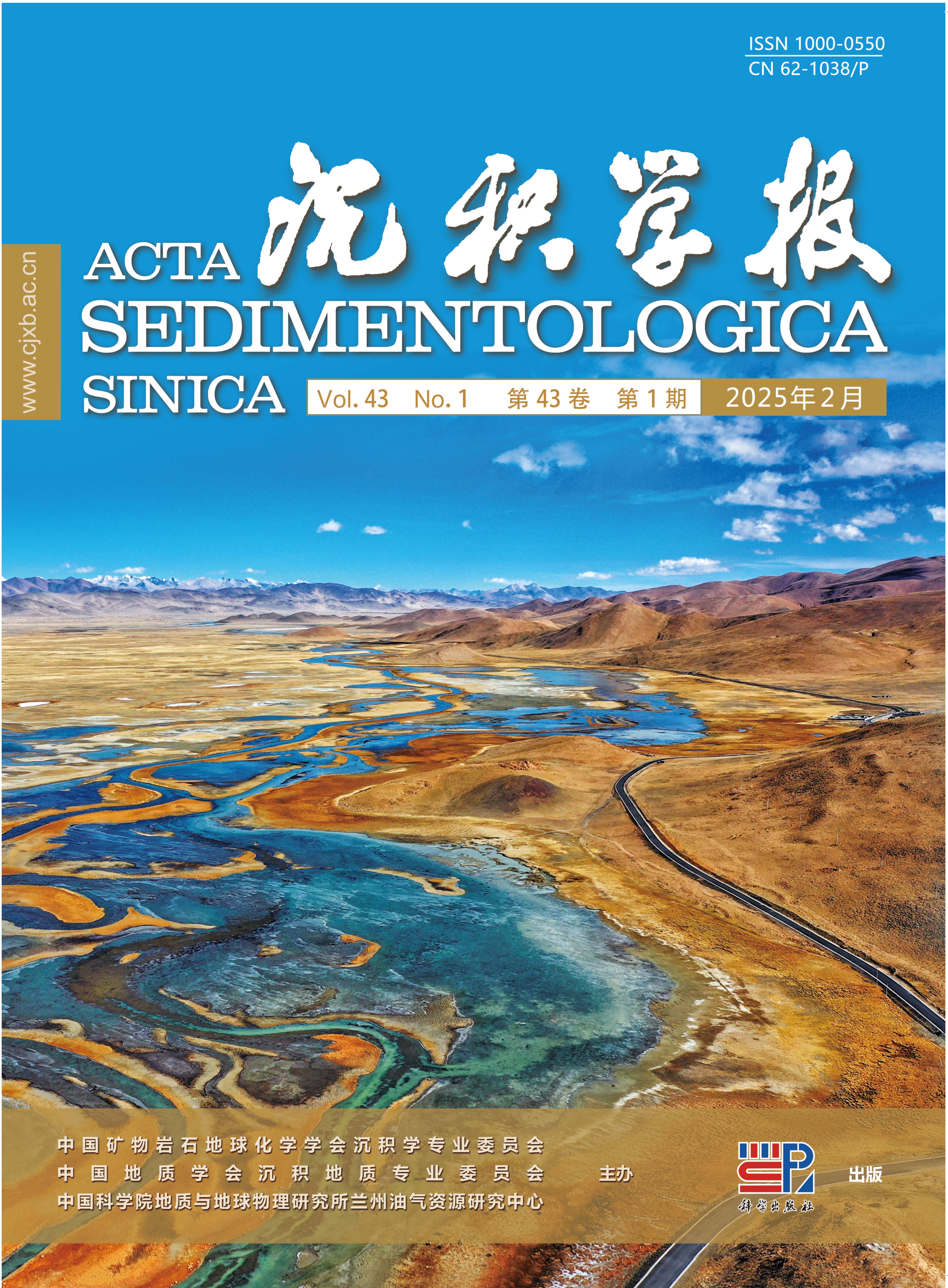2014 Vol. 32, No. 1
Display Method:
2014, 32(1): 1-7.
Abstract:
Most previous studies suggest that the lithofacies palaeogeography of northern Sichuan Basin and Qinling area is the deep-sea slopes or slopes of platform margin during the Sinian-Cambrian. However, in the process of paleogeographic mapping in this a...
Most previous studies suggest that the lithofacies palaeogeography of northern Sichuan Basin and Qinling area is the deep-sea slopes or slopes of platform margin during the Sinian-Cambrian. However, in the process of paleogeographic mapping in this a...
2014, 32(1): 19-26.
Abstract:
The obvious action from ancient landform from Wuling orogeny control the later sedimentary environment in the eastern Guizhou and adjacent area in Neoproterozoic era. Basal conglomerate lithology features reflect on the bottom of Jialu Formation: Se...
The obvious action from ancient landform from Wuling orogeny control the later sedimentary environment in the eastern Guizhou and adjacent area in Neoproterozoic era. Basal conglomerate lithology features reflect on the bottom of Jialu Formation: Se...
2014, 32(1): 36-43.
Abstract:
The Upper Triassic flysch Langjiexue Group is widespread in southern Tibet. It outcrops south to the river Yarlung Zangbo and east to Bailang county, confined by three thrusts: Naidong-Sangri-Langxian Fault in north, Cuona-Milin Fault in east, and R...
The Upper Triassic flysch Langjiexue Group is widespread in southern Tibet. It outcrops south to the river Yarlung Zangbo and east to Bailang county, confined by three thrusts: Naidong-Sangri-Langxian Fault in north, Cuona-Milin Fault in east, and R...
2014, 32(1): 61-67.
Abstract:
Combined with few well drilling and well logging data, and results of previous studies, sequence stratigraphy characteristics and coal accumulation controlling factors of Middle-Lower Jurassic coalbearing series in south margins of Junggar Basin hav...
Combined with few well drilling and well logging data, and results of previous studies, sequence stratigraphy characteristics and coal accumulation controlling factors of Middle-Lower Jurassic coalbearing series in south margins of Junggar Basin hav...
2014, 32(1): 78-84.
Abstract:
73 samples from the typical section of the "Wushan Loess" were analyzed for elemental compositions in order to obtain information about its origin and sediment source. Elemental analysis show that the major elements of the "Wushan Loess" contain SiO2...
73 samples from the typical section of the "Wushan Loess" were analyzed for elemental compositions in order to obtain information about its origin and sediment source. Elemental analysis show that the major elements of the "Wushan Loess" contain SiO2...
2014, 32(1): 93-100.
Abstract:
The authors have studied 7 profiles in Barkol Lake and surrounding areas at northern foothills of Barkol Mount in the eastern Tianshan. By means of sedimentary facies analysis, OSL dating, grain size analysis and magnetic susceptibility measurement, ...
The authors have studied 7 profiles in Barkol Lake and surrounding areas at northern foothills of Barkol Mount in the eastern Tianshan. By means of sedimentary facies analysis, OSL dating, grain size analysis and magnetic susceptibility measurement, ...
2014, 32(1): 110-117.
Abstract:
In Jingbian platform, Ordovician Majiagou 5 member is an important natural gas reservoir in Changqing oilfield. But there exists a long argument about its dolomitization type. This issue has been discussed on the basis of Majiagou 54 sub-member. In t...
In Jingbian platform, Ordovician Majiagou 5 member is an important natural gas reservoir in Changqing oilfield. But there exists a long argument about its dolomitization type. This issue has been discussed on the basis of Majiagou 54 sub-member. In t...
2014, 32(1): 126-137.
Abstract:
Dongpu depression is located in southeastern Bohai Bay Basin, five sets of gypsum-salt rock developed, and the maximum cumulative thickness can be up to 950 m. The lithologic variation of gypsum-salt layer can be divided into three zones including gy...
Dongpu depression is located in southeastern Bohai Bay Basin, five sets of gypsum-salt rock developed, and the maximum cumulative thickness can be up to 950 m. The lithologic variation of gypsum-salt layer can be divided into three zones including gy...
2014, 32(1): 148-158.
Abstract:
Paleozoic clastic sedimentary strata of the Tarim Basin are important oil and gas exploration zones. Permian volcanic rocks are widely distributed in the Tarim Basin, and the abundant, long-term and multistage volcanicmagmatic activities can inev...
Paleozoic clastic sedimentary strata of the Tarim Basin are important oil and gas exploration zones. Permian volcanic rocks are widely distributed in the Tarim Basin, and the abundant, long-term and multistage volcanicmagmatic activities can inev...
2014, 32(1): 166-173.
Abstract:
Through geochemical analysis, physical analysis and mercury intrusion analysis of conventional shale core and sealing drilling shale core, combining with the production oil test, this paper discussed the oil-bearing property of Lucaogou Formation sha...
Through geochemical analysis, physical analysis and mercury intrusion analysis of conventional shale core and sealing drilling shale core, combining with the production oil test, this paper discussed the oil-bearing property of Lucaogou Formation sha...
2014, 32(1): 182-188.
Abstract:
The Pr/Ph ratio has been used widely as a significant biomarker. Except for the sources and palaeosedimentary environments, the Pr/Ph ratio is also affected by the maturity. In this paper, the terrestrial source rocks of different organic phases, tak...
The Pr/Ph ratio has been used widely as a significant biomarker. Except for the sources and palaeosedimentary environments, the Pr/Ph ratio is also affected by the maturity. In this paper, the terrestrial source rocks of different organic phases, tak...
2014, 32(1): 8-18.
Abstract:
During the Late Katian-Hirnantian Age of Late Ordovician, it were deposited Wufeng and Guanyinqiao Formations in the Northwestern Hunan, Wufeng Formation in the central Hunan, Tianmashan and Sushuichong formations in the southern Hunan. According to ...
During the Late Katian-Hirnantian Age of Late Ordovician, it were deposited Wufeng and Guanyinqiao Formations in the Northwestern Hunan, Wufeng Formation in the central Hunan, Tianmashan and Sushuichong formations in the southern Hunan. According to ...
2014, 32(1): 27-35.
Abstract:
Suoxian and Baqing county are located in the south side of Tangula mountain and belong to the Qiangtang stratigraphic area. However, Liuwan Formation of Suoxian and Buqu Formation of Baqing are especially characterized by a lot of organic reefs. Reef...
Suoxian and Baqing county are located in the south side of Tangula mountain and belong to the Qiangtang stratigraphic area. However, Liuwan Formation of Suoxian and Buqu Formation of Baqing are especially characterized by a lot of organic reefs. Reef...
2014, 32(1): 44-60.
Abstract:
Through comprehensive analysis of various outcrops, drilling and seismic sequence stratigraphy, Ordovician sequence stratigraphic framework in Ordos Basin has been established. In view of poor quality of Ordovician seismic data in the basin, a set o...
Through comprehensive analysis of various outcrops, drilling and seismic sequence stratigraphy, Ordovician sequence stratigraphic framework in Ordos Basin has been established. In view of poor quality of Ordovician seismic data in the basin, a set o...
2014, 32(1): 68-77.
Abstract:
It established an analytical method to elucidate the relationship between sediment sources and tectonic evolution by the analyses on heavy minerals type and their assemblages and the characteristics of sandstone detrital component in Kuqa foreland ...
It established an analytical method to elucidate the relationship between sediment sources and tectonic evolution by the analyses on heavy minerals type and their assemblages and the characteristics of sandstone detrital component in Kuqa foreland ...
2014, 32(1): 85-92.
Abstract:
Qaidam Basin develops nearly continuous, integrative and ultra-thick Quaternary sediment sequences. Saline lake deposits are the product of the physic-geographical and geological environments. This paper discussed the sedimentary characteristics of G...
Qaidam Basin develops nearly continuous, integrative and ultra-thick Quaternary sediment sequences. Saline lake deposits are the product of the physic-geographical and geological environments. This paper discussed the sedimentary characteristics of G...
2014, 32(1): 101-109.
Abstract:
It is significant for using China inland basins deposition to obtain the Cenozoic continental climate change records that we appropriately acquire paleoenvironmental proxies and examining their validity for a long-term scale. Water dissolved salts, a...
It is significant for using China inland basins deposition to obtain the Cenozoic continental climate change records that we appropriately acquire paleoenvironmental proxies and examining their validity for a long-term scale. Water dissolved salts, a...
2014, 32(1): 118-125.
Abstract:
The dolomite of Carboniferous in Baizuo Formation in Huize, Yunnan was studied by several methods such as petrological analysis, geochemistry analysis and isotope, in order to understand its geochemical characteristics and genesis. The study area is ...
The dolomite of Carboniferous in Baizuo Formation in Huize, Yunnan was studied by several methods such as petrological analysis, geochemistry analysis and isotope, in order to understand its geochemical characteristics and genesis. The study area is ...
2014, 32(1): 138-147.
Abstract:
A large number of secondary porosity due to quartz overgrowths dissolution, at the top of the Lower Sandstone the bituminous sandstone near the unconformity in Kepingtag Formation, in the Silurian marine clastic reservoirs in the central of Tarim Bas...
A large number of secondary porosity due to quartz overgrowths dissolution, at the top of the Lower Sandstone the bituminous sandstone near the unconformity in Kepingtag Formation, in the Silurian marine clastic reservoirs in the central of Tarim Bas...
2014, 32(1): 159-165.
Abstract:
On the basis of clay mineral X-ray diffraction analysis and trace element analysis, the lake basin paleosalinity of the deposition of Chang 9 reservoir in Longdong area, Ordos Basin has been recovered according to Couch formula and Adams formula. We ...
On the basis of clay mineral X-ray diffraction analysis and trace element analysis, the lake basin paleosalinity of the deposition of Chang 9 reservoir in Longdong area, Ordos Basin has been recovered according to Couch formula and Adams formula. We ...
2014, 32(1): 174-181.
Abstract:
Research indicates that focus merely on the organic carbon content can not meet exploration needs because the characteristics of the shale formation. The most important issue of the exploration is to evaluate the free hydrocarbon content in shale for...
Research indicates that focus merely on the organic carbon content can not meet exploration needs because the characteristics of the shale formation. The most important issue of the exploration is to evaluate the free hydrocarbon content in shale for...



